Case Study
Client:
Wolters Kluwer, TAA (Tax & Accounting)
Roles I’ve served:
The orgs were HEAVY on UI but light on UX (for some, non-existent).
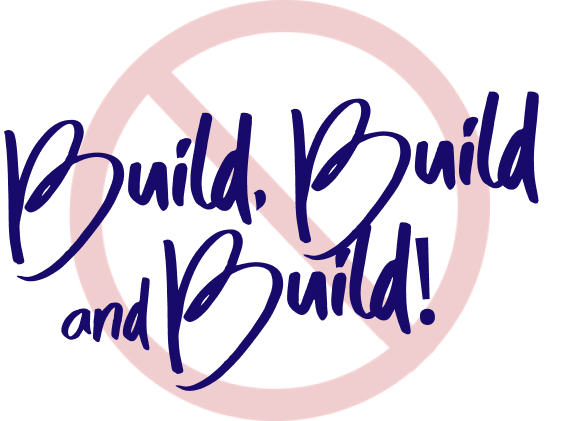
‘Feature-itis’ – a condition where the whole org is focused on delivering features endlessly while usability is low.
Imagine a scenario where a software product adds on features year after year while not taking the time to check if they are actually adding value to User (and are actually being used). Then consider the complexity it creates for the designer to fit in (or hide) the UI, and for the development team to maintain the code.
All of this leads to extra costs for the business and affecting the bottom line just to have it available in the market. All the while it is making it difficult for the User to adapt and will not get used. There’s an infamous company product of this scenario where it had 621 features in its 10+ years of existence. When a proper study was done it showed that less than 5% of the features were used with regular frequency. The remaining features were perhaps gets used once in awhile or for extreme edge cases. This begs to question to the whole org then, “why are you making life so difficult for your Users and yourselves”?
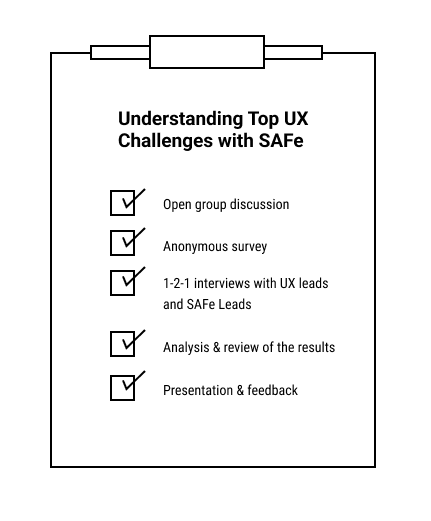
Having had witnessed a few SAFe rituals from several countries and formulated my own observations, it was necessary to hear from the UX managers of those organizations. We’ve had multiple group discussions with representations from all the countries and had discovered common pain-points as patterns. It was followed up with anonymous surveys, individual interviews to get the context & detailed scenarios. The below were the top common patterns:
If research is cut off, UX is unable to contribute its most valuable skills to the org (at start of the process) with insights gathering & test experiements…
At this trajectory, it was probable that a revolving door in UX recruitment will continue; UX teams are experiencing hired UX designers leaving and are mainly replaced with UI/Visual designers to focus on final designs for UI production. Meanwhile the orgs run the risk of producing features & products which will not be adopted by Users due to little or no UX done.
It was time to mind-map & discuss potential remedies on tackling the issues raised. The UX managers / Leads themselves had clear ideas on how to improve the situation moving forward as illustrated below.
This council of UX Leads had come to realization in these sessions together that although there are cases of nuanced factors for each country but have shared many common pain-points as patterns as well. They’ve now a shared understanding on what challenges they all face together.
It was a chronic issue with having the wrong mindset, misunderstanding when to engage (and not engage) UX, and jumping into solutions without truly understanding what the problem is to solve…
It was clear that the problem is rooted with training & cultural issues within their organizations. Now the question was HOW to overcome this.
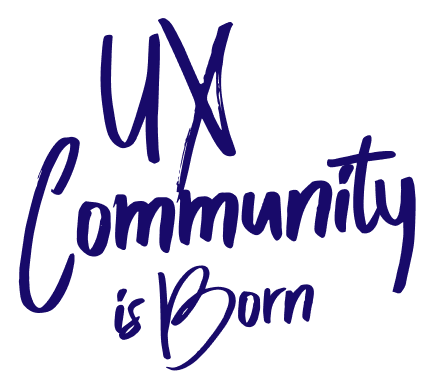
To ensure a level of consistency/standards to be set by the UX community of best practices & principles, a training program had begun consisting of guest speakers & trainers I’ve invited into the coaching staff. We were investing into our UX leads/managers for 12 months with cadenced workshops on best practices & principles in UX –in order for them to bring back to their orgs and train their colleagues themselves.
Firstly, a community for UX was required, a place of learning as well as sharing of insights, ideas with each other, and to support one another. In the first month, I’ve nurtured & led a community of UX managers from the countries– as the ‘Agents of Change’. Initially it was exclusive to the heads of UX from each countries intentionally to focus on strategy & high-level issues (and filter out noise). In the 2nd year, we’ve expanded this community to a wider audience in a separate channel, engaging cross-functional colleagues, designers , developers, even HR managers.
The community bonded naturally with the discovery of common pains and obstacles for UX across the countries. The discussions of possible remedies led me to focus on including training programs for the whole community– to train the trainers, the UX managers to bring the best practices to their orgs

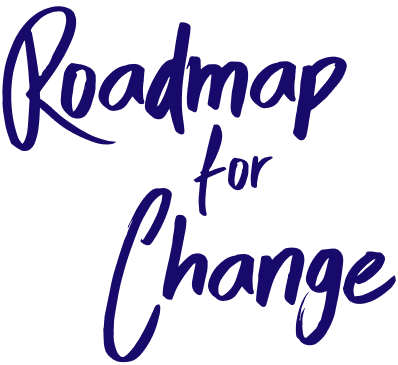

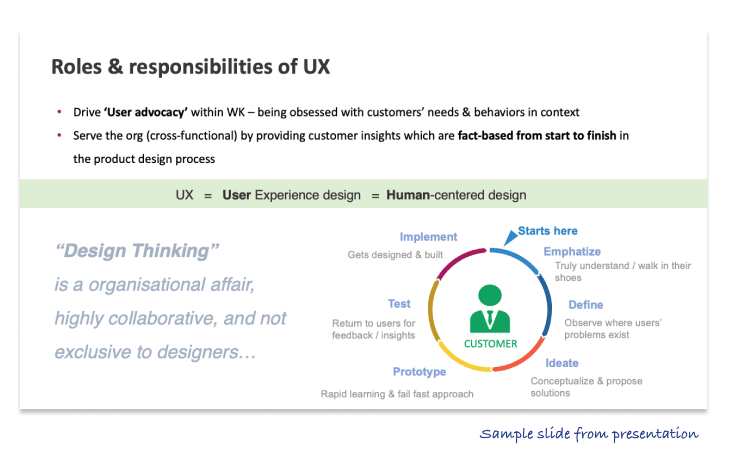
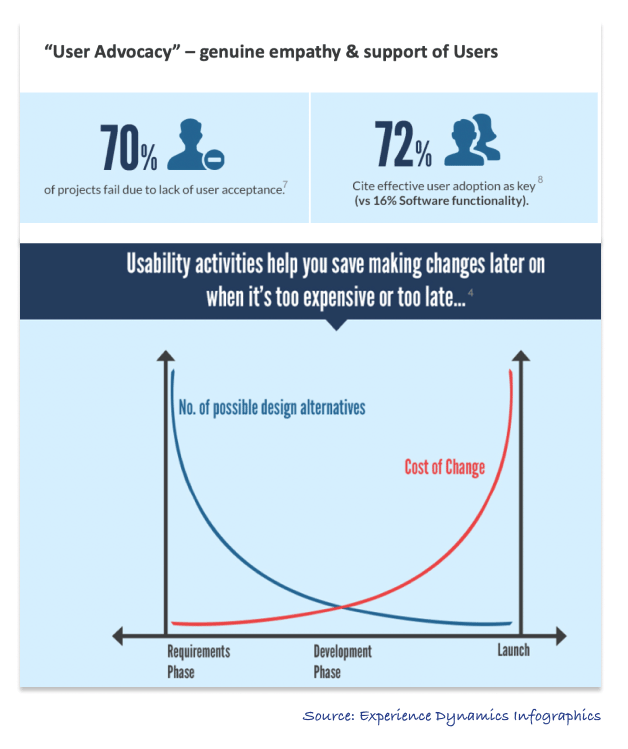
In addressing the Heads of product in Europe in a presentation, it was critical to be aware that it was a mixed group with some are already advocates of Human-centered Design and some were detractors, and many were in the middle. Quite frankly, even UXers get confused with many buzz-words of various methodologies. We’ve spent the opening 7 minutes discussing how it all is at the core the same – having the Customer & his needs at the center of the process. And its execution depends on not UX designers exclusively but from non-designers, Product managers as well. In fact it’s a whole organizational affair in order to work.
Debunking the myth that User research was too costly & adds excess time was the next point to get across, with examples of modern tools & practices for ‘rapid learning’ experiments to get validation on key decisions on design. In the same context, a clear distinction of focus & responsibilities between UX & UI was explained. As many UX departments reported under Product, it was essential that they were aligned on UX skill-sets for future recruitment.
Statistics & figures sit well with Product executives, it was important to speak their business language in order to get a good outcome from the presentation. Facts show that approx. 70% of new software products fail due to Users not accepting the products. Hence User adoption is key to beat the percentages and meet success. In order to gain User adoption, User advocacy is essential– a practice of having genuine empathy with Users. In order to achieve genuine empathy (and not remote empathy which is far worse) a discipline of consistent HCD (Human Centered Design) needs to be practiced, connecting back to the earlier point in the need for UX.
Imagine having to spend 3-4 years in UI design & development and to realize that it failed when released in the market due to lack of User adoption; one can easily quantify the cost of that failed venture – all due to skipping on UX and focusing solely on UI. Another example showcased was the system (still in the market) which has 621 features while only 5% of them are actually used regularly by customers. One can quantify the costs of maintaining those unused features in code as well as UI design efforts in the coming years. And if we add on the costs of cognitive taxing those features enforce on Users, the costs are overwhelming to the brand & the business.
The cost for design changes skyrockets if UX is consulted at the end (near launch date). In comparison, if UX is approached at the start the costs in those changes are at its lowest with the benefit of higher maneuverability for options. In my experience, whenever UX is brought in at the end the UX recommendations gets ignored by tech/business due to lack of time & costs involved – leading to a deficient product to release and adding risks of failed User adoption.
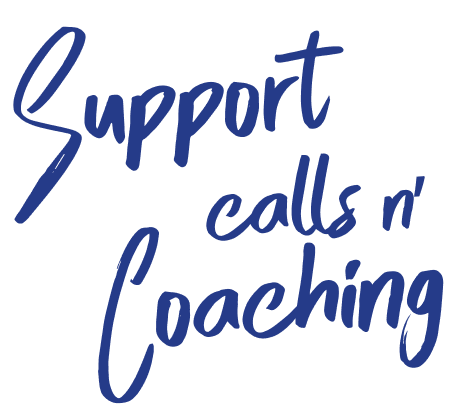
1-to-1 meetings to listen & coach
Finding the gaps & talking through probable remedies together…
Further tailored training & guidance, fortnightly

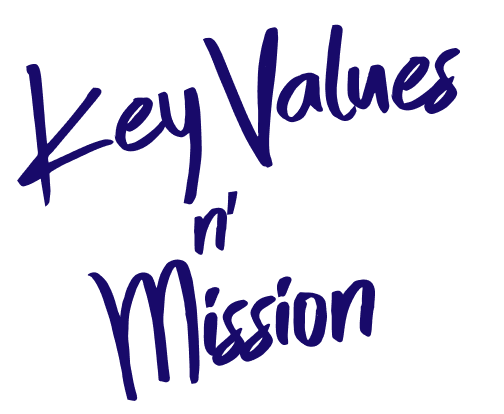
Mapping shared goals as a community – a Mission Statement based on common Values.
I had confidence in the UX leads to arrive to the all-important declaration of what the community’s key values are, and its ultimate mission. Dot democracy was used to vote on various statements outputted from the session.
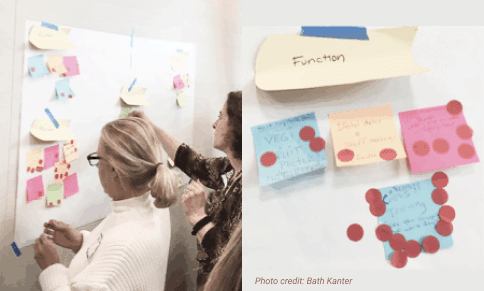
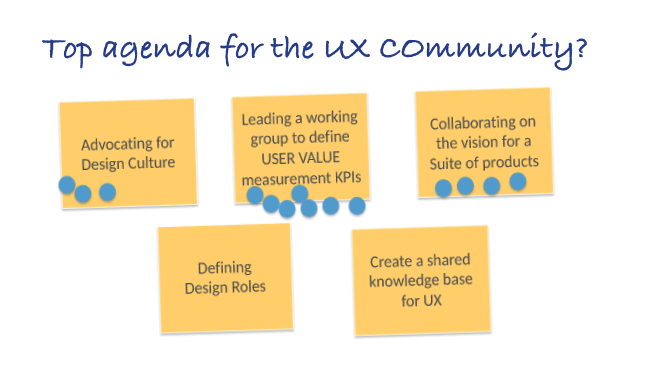
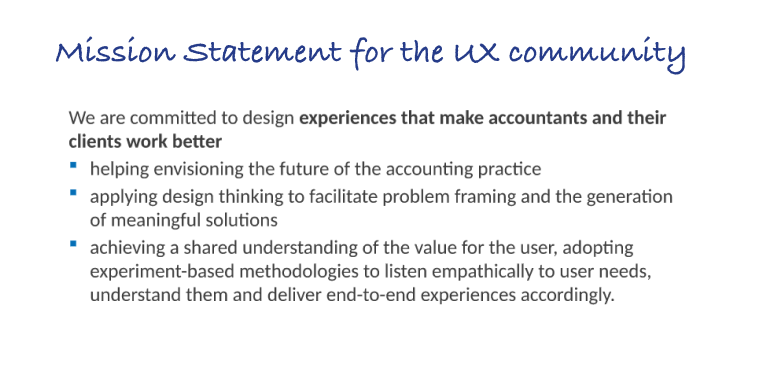
Self-realization as a group was far more powerful than having an executive or a boss tell that how it should be. They own this declaration as their own to march forward, self-motivated.
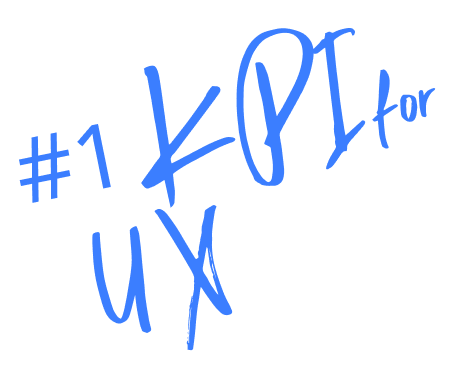
“What gets measured gets done.”
– Peter Drucker
By establishing clear operational metrics and evaluate performance, companies have the advantage of using what is crucial to stay competitive in the market, and that’s data.
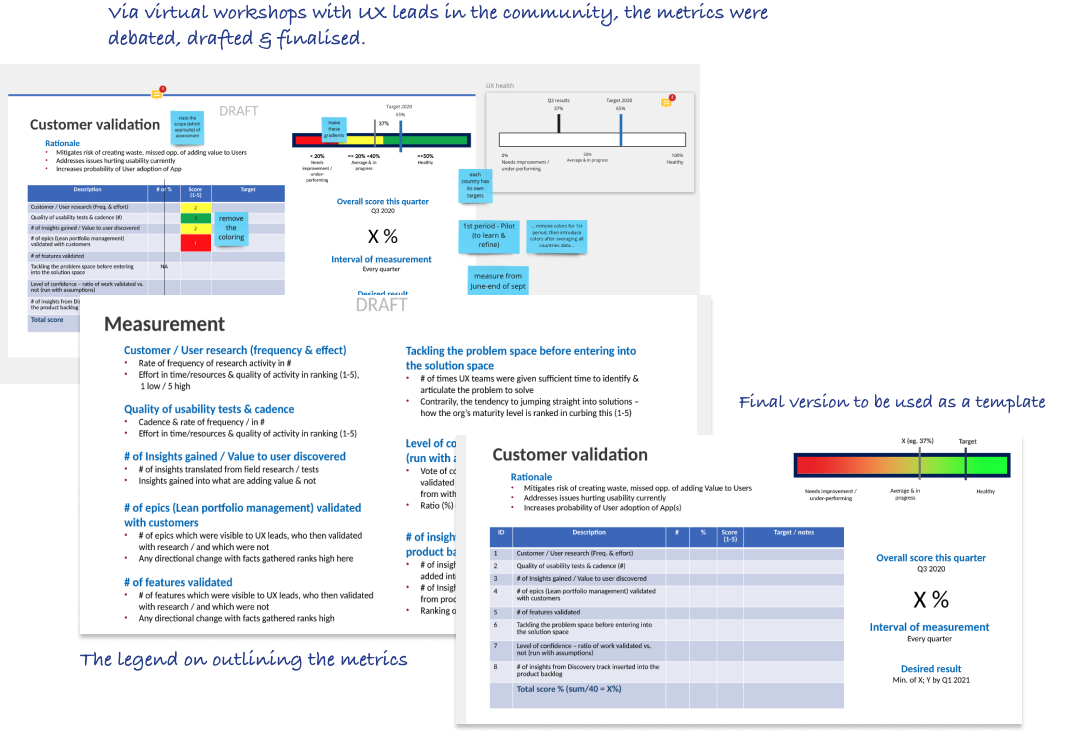
It was to be an whole wide org’s affair with collaborations from collegues from Tech & PM were expected & to be measured at intervals of 3 months led by the country’s UX lead. Key items in the metrics included:
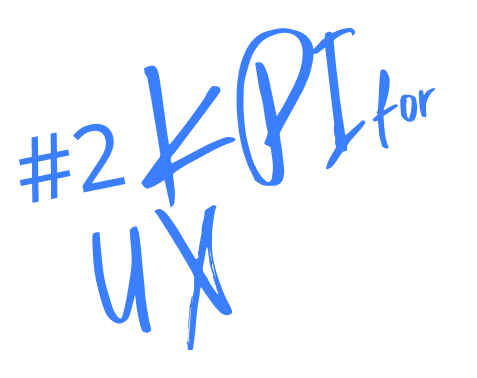
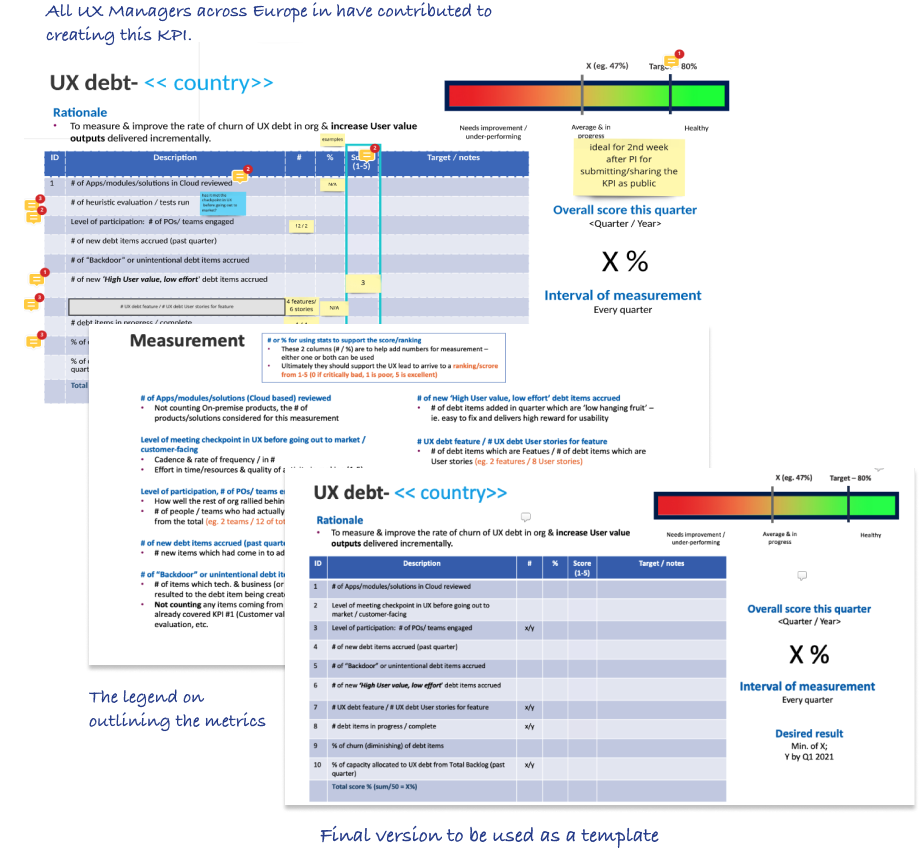
Running up UX debt exponentially & getting forgotten over time was a common issue experienced by all 9 countries.
Each unpaid UX debt leads to negative implications to the company’s success as poor usability hurts the bottom line.
Working together towards reducing the debt would be in the interest of everyone in the company.
Key items in the metrics included:
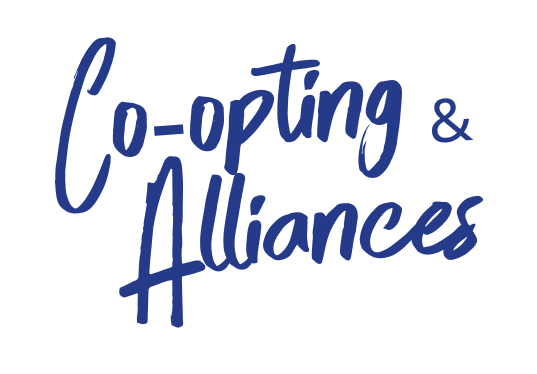
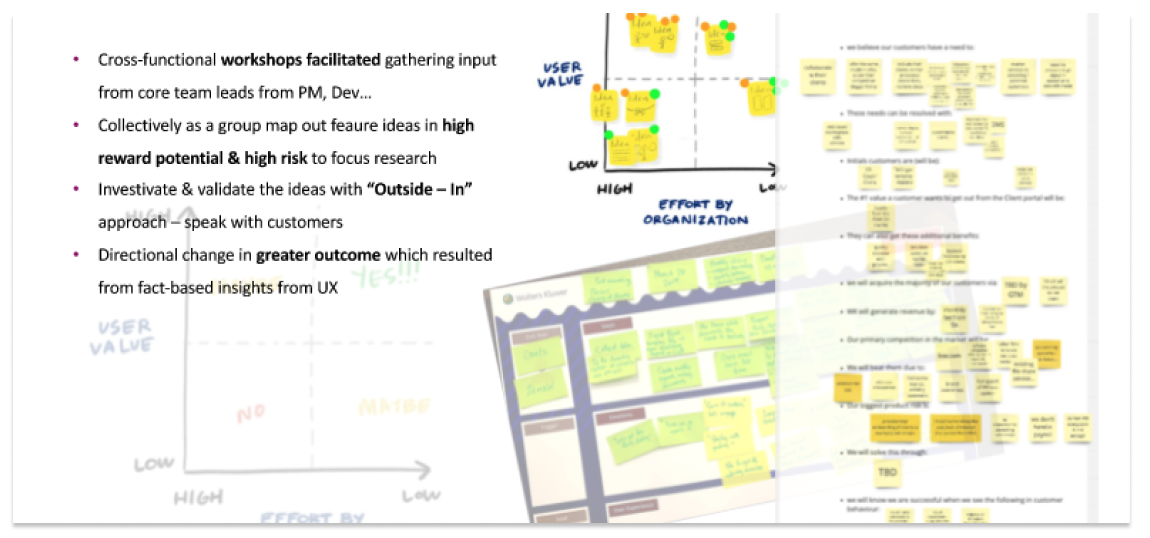
Looking for bright spots & alliances from each functions to co-opt into the movement of the UX cultural change…
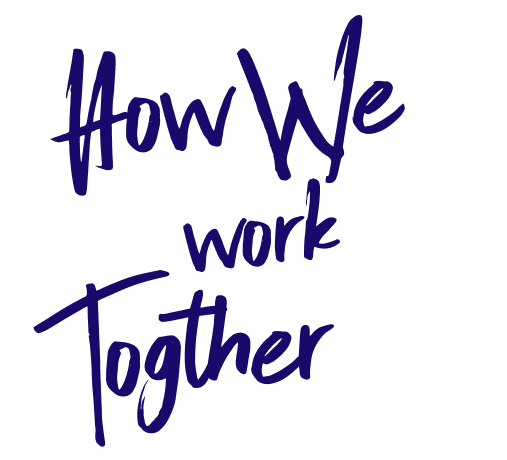
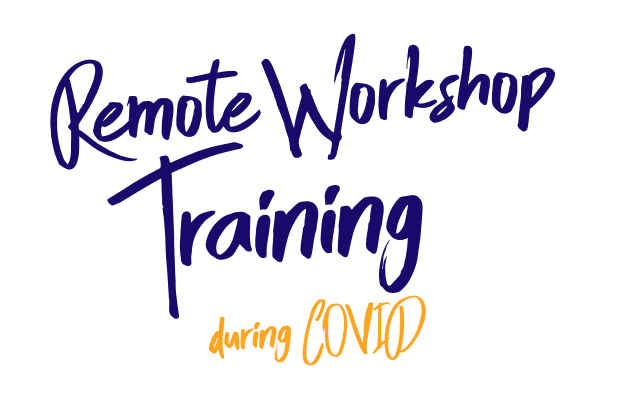
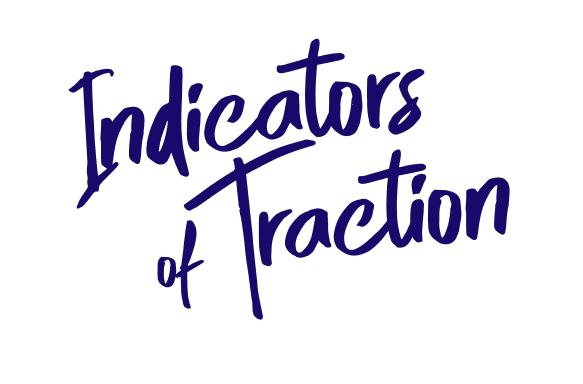
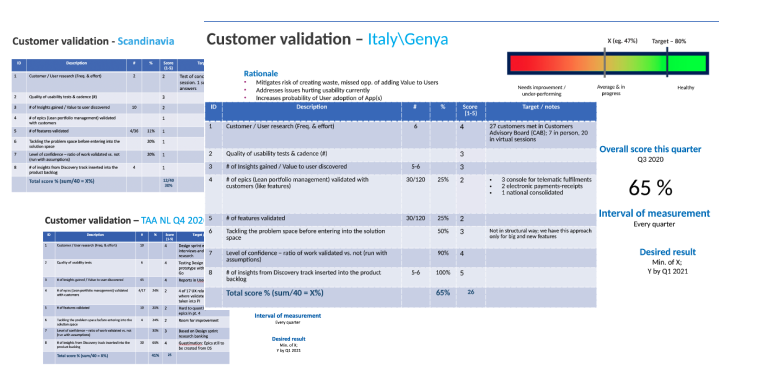
Cross-functional collegues showing more attention & engagement in User research across countries, the rate gets measured every 3 month intervals…
Changing culture will take time, we knew this coming in. But placing seminal activities & training to jump-start an on-ramp to that journey was accomplished. I had estimated 3-4 years on average in reaching their peaks in maturity.

I wish to thank my coaching staff & partners including Vikenti Kumanikin & Marcello Coppa. Without them it would not have been possible to cover so much ground and at such high quality for the UX Community for those years together.